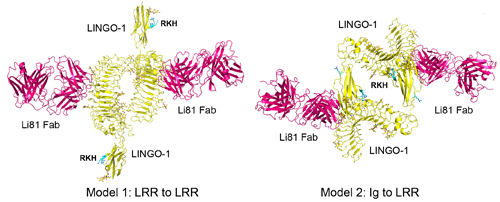January 8, 2015 /
BIIB033, a monoclonal antibody targeting the LINGO-1 remyelination signaling block, passes phase 1 safety tests
BIIB033, a monoclonal antibody targeting the LINGO-1 remyelination signaling block, passes phase 1 safety tests
CAROL CRUZAN MORTON
A high-profile experimental treatment to repair the damaged myelin around nerves in people with multiple sclerosis (MS) has passed its first clinical testing milestone. The drug, a monoclonal antibody called BIIB033 (Biogen Idec), is safe and tolerable in people, according to the combined results of two phase 1 clinical trials that tested high doses inhealthy people and in people with MS.
“We have now reached a potential turning point in MS therapeutics,” according to an editorial published online August 27 with the phase 1 study results in the journalNeurology, Neuroimmunology & Neuroinflammation (Brugarolas et al., 2014; Tran et al., 2014).
“The anti-LINGO-1 trial is likely the first of many that will test drugs that have been shown to enhance remyelination in [mouse] models,” wrote Pedro Brugarolas, Ph.D., and Brian Popko, Ph.D., of the University of Chicago, Illinois, in the editorial. “Soon we should know whether this approach will provide benefit to patients with MS, which would be the first evidence that enhancing myelin repair may alter the course of this disease.”

The antibody Li81 (BIIB033, Biogen) in hot pink binds to the signaling molecule LINGO-1 (yellow) in an unexpected four-way structure to induce myelination, shown here in two potential configurations. Image courtesy of Sha Mi and the Journal of Pharmacology and Experimental Therapeutics (Pepinsky et al., 2014).
With no proven treatments for the progressive forms of MS that cause severe disability, attention has become riveted on ways to repair and restore the myelin that surrounds and protects axons from neurodegeneration (Franklin et al., 2014).
~~~~~~~~~~~~~~~~~~~~
.
.
.
Visit our MS Learning Channel on YouTube: http://www.youtube.com/msviewsandnews
Stay informed with MS news and information - Sign-up here
For MS patients, caregivers or clinicians, Care to chat about MS? Join Our online COMMUNITY CHAT



